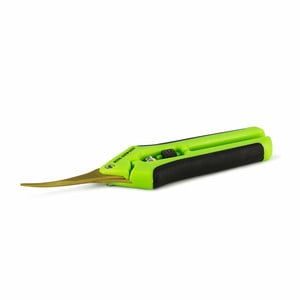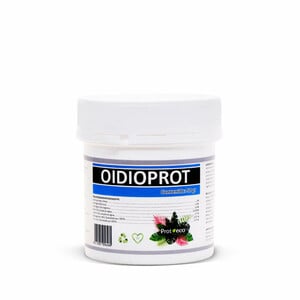 Weed Grow Guide by Royal Queen Seeds
Weed Grow Guide by Royal Queen Seeds
- Growing weed step by step
- Cannabis growing basics
- Choosing your seeds
- How to germinate seeds
- The cannabis vegetative stage
- The cannabis flowering stage
- Harvesting cannabis
- Trimming, drying, and curing
- Choosing pots and soil
-
Growing indoors
- A Complete Overview Of Growing Cannabis Indoors
- Cannabis Cultivation Tips: How To Set Up Indoor Grow Lights
- How Many Cannabis Plants Can You Grow Per Square Metre?
- Indoor Cannabis Growing: Relative Humidity and Temperatures
- Hydroponics Cannabis Growing Guide (with diagrams)
- Cannabis Micro Growing: Growing Great Weed in Tiny Spaces
- Growing outdoors
- How to grow autoflowering cannabis
- Cannabis nutrients and pH
- Cannabis troubleshooting: Nutrients
-
Cannabis troubleshooting: Growing
- Cannabis Seed Germination — Troubleshooting Guide
- How to Deal With Pythium (Root Rot) in Cannabis Plants
- Slow Cannabis Plant Growth And What You Can Do About It
- How to Deal With Leggy Cannabis Seedlings
- Watering Your Cannabis: How to Fix Overwatering and Underwatering
- Understanding Male, Female, And Hermaphrodite Cannabis
- Identifying and Treating Common Cannabis Ailments
- How To Revive a Sick Cannabis Plant
- How to Avoid Mouldy Weed During Drying and Curing
- How to Prevent and Treat Dry and Crispy Cannabis Leaves
- What Cannabis Leaves Can Tell You
- Causes and Solutions for Yellow Cannabis Leaves
-
Cannabis Strains Grow Report
- HulkBerry Automatic Grow Report
- Blue Cheese Auto Grow Report
- Purple Punch Automatic Strain Grow Report
- Triple G Automatic Grow Report
- Do-Si-Dos Automatic Grow Report
- Green Gelato Automatic Grow Report
- Haze Berry Automatic Grow Report
- Purple Queen Automatic Grow Report
- Cookies Gelato Automatic Grow Report
- Sherbet Queen Automatic Grow Report
- Sweet Skunk Automatic Grow Report
- Medusa F1 Grow Report
- Cannabis plant training
-
Weed growing tips
- The Cannabis Plant Anatomy
- How to preserve seeds - UK
- How Much Sunlight Do Outdoor Cannabis Plants Need To Grow?
- How to Control and Prevent Stretching in Cannabis Plants
- My Cannabis Plants Are Growing Too Tall: What Should I Do?
- Should You Worry About Purple Or Red Cannabis Stems?
- What To Do When Your Indoor Cannabis Won’t Flower
- How To Protect Your Cannabis Plants From Heat Stress
- How To Tell If Your Female Cannabis Plant Has Been Pollinated
- Growing Medical Marijuana
- Bud Washing: How to Clean Your Weed
- Understanding Cannabis Yield per Plant

When To Harvest Cannabis Plants
Harvest time is without a doubt every grower's favourite date on the calendar. But since the time of harvest can greatly impact the potency and effects of your weed, it's crucial you harvest your buds at the right time.
Contents:
How To Tell When Cannabis Is Ready To Harvest
Seedbanks often provide rough harvest date estimates for their strains, which can serve as a roundabout estimate of when you can expect your plants to be ready to harvest.
A strain's genetics can also provide you with some idea of how long it will take for your plants to reach maturity.
Sativa strains typically take longer to flower than indicas, probably because they stem from warm regions with long summers. Our Shining Silver Haze, for example, has a flowering time of around 11 weeks (which is still considered short for a Haze variety) while our Special Kush 1 takes just 7-8 weeks to flower.
The best way, however, to know whether your plants are ready to harvest is by simply looking at them. Mature cannabis plants develop a number of tell-tale signs, including:
1. Yellowing Leaves


Yellowing leaves are usually a sign of a nutrient deficiency or a pathogen/pest problem during the vegetative growth phase. However, during the flowering phase, it's very normal for cannabis plants to develop yellowing foliage. This usually starts in the fan leaves (i.e. the large, broad leaves beneath buds and nodes) and gradually spreads to smaller leaves closer to the flowers as your plants use up nutrients stored in their old foliage and concentrate all their energy on developing bigger, heavier buds.
In healthy, maturing cannabis plants, you'll see older leaves towards the bottom of the canopy start to turn yellow first. As the plants continue to mature, older foliage towards the middle and top of the plant will follow suit and start to turn yellow. Left to their own devices, cannabis plants may eventually also develop yellow sugar leaves and buds as they slowly approach the end of their life cycle—obviously, you'll want to avoid this and harvest your plants while their flowers are still vibrant and green.
Note: Depending on the genetics you're working with, you may also see your plants developing pink, purple, and even deep black hues as they mature. This is largely determined by genetics and environmental conditions (cooler temperatures during flowering can encourage plants to develop purple flowers).
Curious about the lifecycle of your plants? Our growing guide can help you start on the right foot!
Free RQS
Grow Guide!

2. Orange Pistils


Remember the white hairs that started producing from your plants' flowers as they began flowering? These are pistils, and they are actually the sex organs of female cannabis plants designed to catch pollen released into the air by male plants. As flowers mature, these pistils will change colour, turning from pale white to orange/amber. Most growers harvest their flowers when roughly 90% of a plant's pistils have turned orange, as THC concentration is considered to be at its highest at this time.
3. Plump calyxes
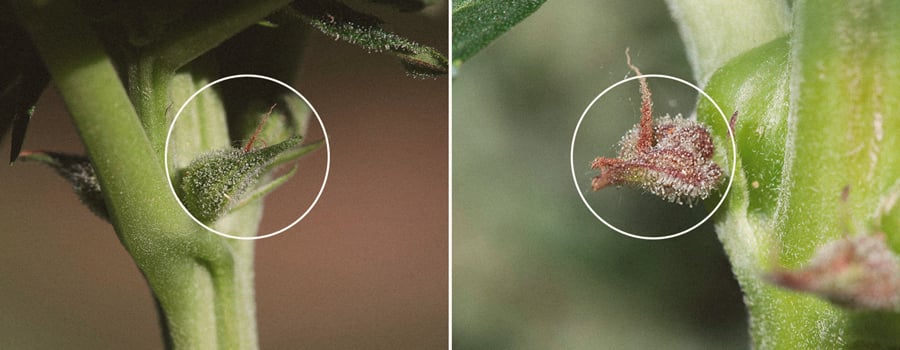
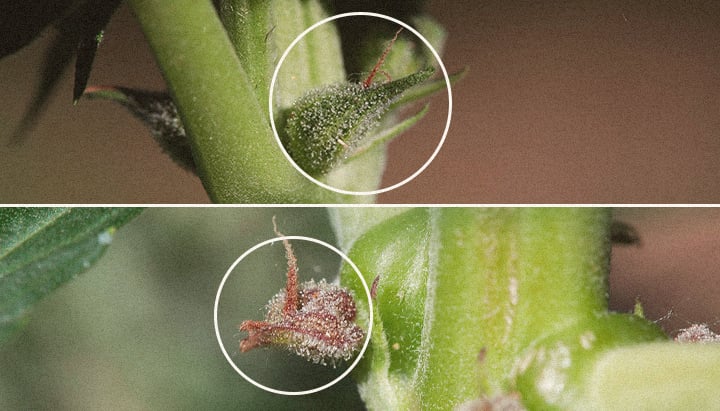
Calyxes are the bulbs that house a female cannabis plant's pistils. They are the most resinous part of a cannabis plant and, besides also making up the structure of cannabis flowers, can be a good indicator of a plant's maturity. In general, cannabis calyxes become plump as flowers mature and go unfertilized for prolonged periods of time.
As your cannabis plants begin to flower, you should notice their calyxes become notably "fatter" over time. Once they look nice and plump and protrude fiery orange pistils, it's time to take out your microscope and inspect your plant's trichomes for a final verdict on whether it is indeed harvest time.
4. Milky/Amber/Clear Trichomes


The best way to know that your cannabis plants are harvest-ready is by looking at their trichomes using a microscope or jeweler's loupe. Trichomes are resin glands and make up the frosty, sticky coating found on cannabis flowers. In isolation and under a microscope, single trichomes look like little glass mushrooms, beads, or hairs. As cannabis flowers mature, their trichomes go from crystal clear to milky white and finally, amber.
Most growers opt to harvest their flowers when around 70% of their trichomes have turned milky or cloudy, signaling peak THC production. 15% should remain clear, while 15% should have progressed past being milky and become amber.
Harvested at this time, flowers are believed to produce a more potent head-high, while flowers harvested later are believed to be richer in CBN (cannabinol) and therefore produce a more relaxing, physical stone. Buds with mostly clear trichomes are thought to be less potent and have more clear-headed effects.
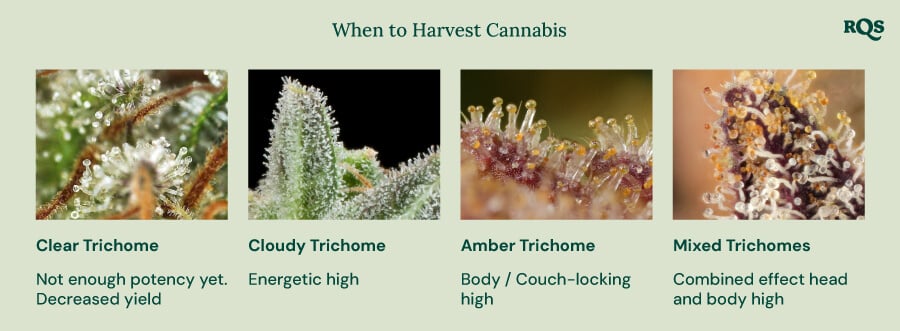
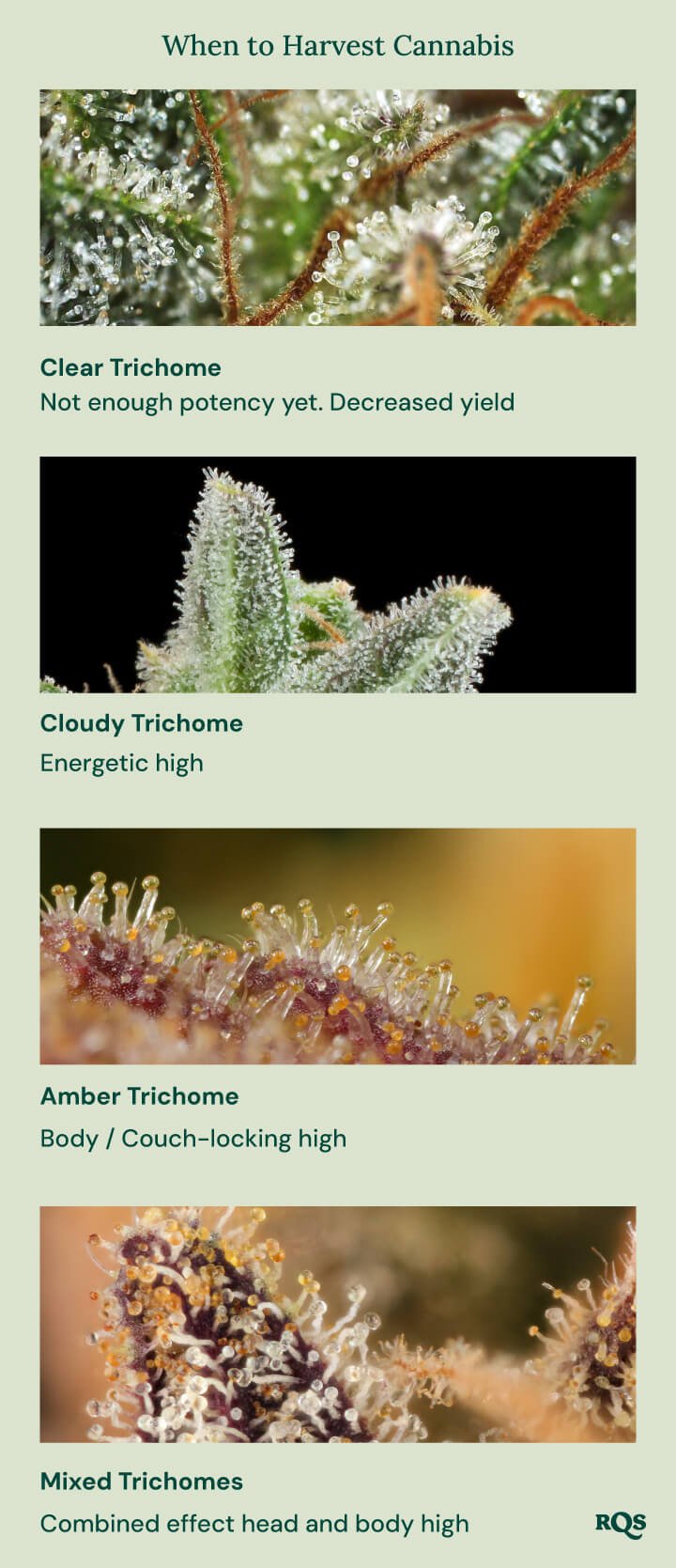
How to Harvest Marijuana Plants
Once you've confirmed that your cannabis plants are ripe, it's time to harvest! While most growers have their own ways to harvest that may vary slightly, the basics of harvesting weed just involve:
- Cutting down your live plants.
- Trimming away large fan and sugar leaves from the flowers (wet trimming). You can skip this step if you prefer to dry trim your plants.
- Hanging entire plants or separate branches to dry in a dark, dry room.
- Trimming away fan and sugar leaves (you can skip this if you wet-trimmed your plants). Learn more about the differences and benefits of wet vs dry trimming here.
- Curing your flowers in glass jars to enhance their flavour and potency.
The Best Time to Harvest Cannabis Plants
Knowing how harvest time affects the potency and effects of your flowers, you'll know exactly when to cut down your plants to ensure your bud has the effects you most desire.
Remember that, in general, the later you harvest your buds, the more relaxing their effects will be.
For a more detailed discussion about whether to harvest your buds early or later in the season, click here.
Can You Harvest Cannabis With Powdery Mildew?
Powdery Mildew is a fungus that commonly affects cannabis and other plants. As its name suggests, it forms a white, flour-like powder on cannabis leaves and buds. While it can be treated when detected on vegging plants, any cannabis flowers with white powdery mildew need to be discarded as they contain fungal spores that can be extremely detrimental to humans if consumed.
If you spot Powdery Mildew during the veg cycle, be quick to treat your plants with a combination of insecticidal soap and neem oil or a natural fungicide. Check out our guide for Preventing and Treating Cannabis Mould Infections for a detailed walkthrough of how to fend off White Powdery Mildew and other cannabis moulds. Remember that most cannabis moulds are extremely efficient at producing spores, so you'll need to follow the instructions in our article to a T to minimize the damage they cause.
If, on the other hand, you spot Powdery Mildew on flowering cannabis plants, there is little else you can do but cull the infected plants to avoid the fungus spreading. While some growers try to save those buds that aren't visibly affected by the fungus, we would recommend against this as even unaffected buds likely contain fungal spores.
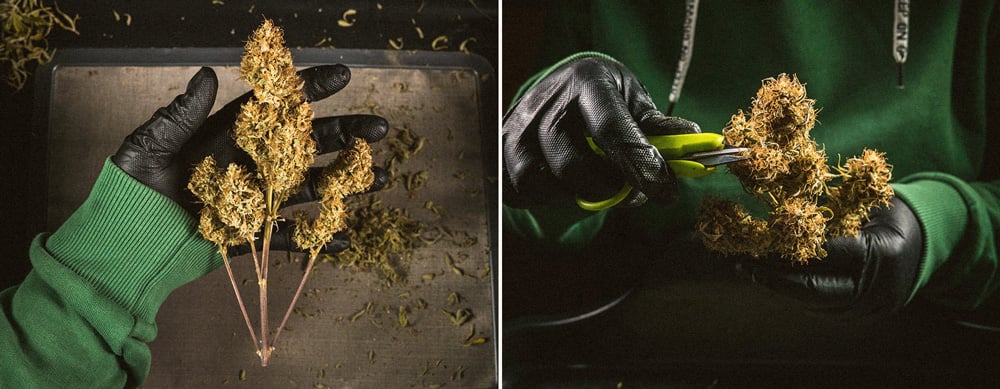
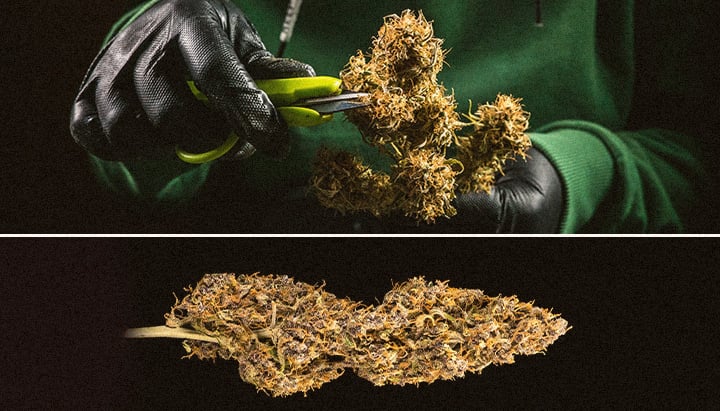
When To Harvest Cannabis Seeds
While sinsemilla (seedless) cannabis cultivation revolutionized the cultivation of cannabis flowers for recreational and medical use, not all cannabis plants are grown for their buds. Breeders, seedbanks, and hemp seed producers need their female plants to be pollinated for their business. And like unpollinated flowers, cannabis plants that are grown for seeds also need to be harvested at the right time to ensure the highest quality seeds.
Remember that pollinated cannabis flowers take longer to mature than unpollinated flowers. Also, there is more room for error when harvesting cannabis seeds, as harvesting seeds before they're ripe can affect their germination rate. Generally speaking, the best way to test if a pollinated female cannabis plant is ready for harvest is to inspect one of its seeds. Mature seeds will have a large, full shape and a darker brown hue with black tiger stripes. Premature seeds, on the other hand, will look smaller and have a pale green or beige hue, with no striping.
How To Harvest Cannabis Pollen
While most hobby growers will cull male or hermaphrodite plants, cannabis breeders treasure them for their pollen, which can contain the genetics for strong, resilient hybrids. In order to ensure the pollen you harvest is of the highest quality, it's important to collect it as soon as a male plant opens its pollen sacs. This usually occurs a few weeks after male plants start flowering. The easiest way to harvest pollen is to remove entire male flowers and dry them in a sealed container over several days. The dried flowers can then be shaken over a micron screen to separate the pollen from the plant matter.
To store the pollen, preserve it, and particularly protect it against moisture, many breeders mix their pollen with flour.
What Happens If You Don’t Harvest Cannabis?
If cannabis plants are left unharvested, they'll typically complete their lifecycle and wither away. In nature, when this happens, the seeds of a pollinated female would be released into the air and ground, paving the way for the upcoming generation of cannabis plants. Furthermore, cannabis plants possess an innate desire to reproduce. When they do not receive fertilization from male pollen, certain plants experience elevated levels of stress, which can result in hermaphroditism—a condition where they produce male flowers in a desperate effort to self-pollinate. If this endeavour proves successful, it leads to the formation of inferior buds that contain a large number of seeds. This process is commonly known as "rodelization."
Get Your Harvest On!
Now that you know how to effectively harvest cannabis flowers, seeds, and pollen, it's time to get back in the garden. Make sure to keep this article handy to help identify mature cannabis flowers and harvest your buds at the right time to ensure they have the potency and effects you're after. Plus, remember to bookmark our blog for more cannabis grow tips.
 Grow Guide Topic Finder
Grow Guide Topic Finder
- Growing weed step by step
- Cannabis growing basics
- Choosing your seeds
- How to germinate seeds
- The cannabis vegetative stage
- The cannabis flowering stage
- Harvesting cannabis
- Trimming, drying, and curing
- Choosing pots and soil
-
Growing indoors
- A Complete Overview Of Growing Cannabis Indoors
- Cannabis Cultivation Tips: How To Set Up Indoor Grow Lights
- How Many Cannabis Plants Can You Grow Per Square Metre?
- Indoor Cannabis Growing: Relative Humidity and Temperatures
- Hydroponics Cannabis Growing Guide (with diagrams)
- Cannabis Micro Growing: Growing Great Weed in Tiny Spaces
- Growing outdoors
- How to grow autoflowering cannabis
- Cannabis nutrients and pH
- Cannabis troubleshooting: Nutrients
-
Cannabis troubleshooting: Growing
- Cannabis Seed Germination — Troubleshooting Guide
- How to Deal With Pythium (Root Rot) in Cannabis Plants
- Slow Cannabis Plant Growth And What You Can Do About It
- How to Deal With Leggy Cannabis Seedlings
- Watering Your Cannabis: How to Fix Overwatering and Underwatering
- Understanding Male, Female, And Hermaphrodite Cannabis
- Identifying and Treating Common Cannabis Ailments
- How To Revive a Sick Cannabis Plant
- How to Avoid Mouldy Weed During Drying and Curing
- How to Prevent and Treat Dry and Crispy Cannabis Leaves
- What Cannabis Leaves Can Tell You
- Causes and Solutions for Yellow Cannabis Leaves
-
Cannabis Strains Grow Report
- HulkBerry Automatic Grow Report
- Blue Cheese Auto Grow Report
- Purple Punch Automatic Strain Grow Report
- Triple G Automatic Grow Report
- Do-Si-Dos Automatic Grow Report
- Green Gelato Automatic Grow Report
- Haze Berry Automatic Grow Report
- Purple Queen Automatic Grow Report
- Cookies Gelato Automatic Grow Report
- Sherbet Queen Automatic Grow Report
- Sweet Skunk Automatic Grow Report
- Medusa F1 Grow Report
- Cannabis plant training
-
Weed growing tips
- The Cannabis Plant Anatomy
- How to preserve seeds - UK
- How Much Sunlight Do Outdoor Cannabis Plants Need To Grow?
- How to Control and Prevent Stretching in Cannabis Plants
- My Cannabis Plants Are Growing Too Tall: What Should I Do?
- Should You Worry About Purple Or Red Cannabis Stems?
- What To Do When Your Indoor Cannabis Won’t Flower
- How To Protect Your Cannabis Plants From Heat Stress
- How To Tell If Your Female Cannabis Plant Has Been Pollinated
- Growing Medical Marijuana
- Bud Washing: How to Clean Your Weed
- Understanding Cannabis Yield per Plant


























